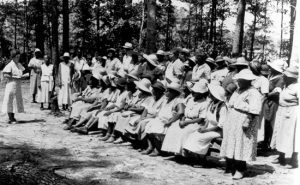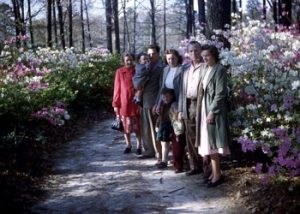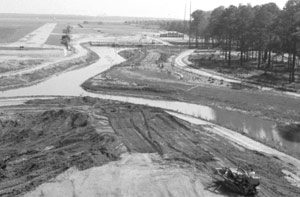Who Built The Botanical Gardens Norfolk
The Idea
The idea for what would eventually become Norfolk Botanical Garden came from Thomas P. Thompson, Norfolk City Manager 1935-1938, and Frederic Heutte, a young horticulturalist. Heutte had a fondness for azaleas and thought Hampton Roads had a climate uniquely suited for growing the plants. Thompson and Heutte believed that Norfolk could support an azalea garden to rival those of Charleston, S.C., which even during the depression years drew thousands of tourists annually.
The city of Norfolk provided Thompson and Heutte with a seventy-five acre section of high, wooded ground and another seventy-five acres of the Little Creek Reservoir to establish a city garden.
Getting Started

WPA workers in the original garden – photo courtesy Norfolk Public Library
On June 30, 1938, Representative Norman R. Hamilton announced a Works Progress Administration (WPA) grant of $76,278 for the Azalea Garden project.
Since most of the male labor force was at work with other projects for the city, a group of more than 200 African American women and 20 men were assigned to the Azalea Garden project.
Laboring from dawn until dusk, the labor crew cleared dense vegetation and carried the equivalent of 150 truck loads of dirt by hand to build a levee for the lake. The laborers were paid twenty-five cents an hour for their hard work.
Within less than a year, a section of underbrush had been cleared and readied for planting. By March of 1939, four thousand azaleas, two thousand rhododendrons, several thousand miscellaneous shrubs and trees and one hundred bushels of daffodils had been planted.
In August of 1939, Representative Colgate W. Darden Jr. secured an additional $138,553 for the Azalea Garden, and the founding of the Old Dominion Horticultural Society provided volunteer labor to assist the Garden. By 1941 the Garden displayed nearly five thousand azaleas, and seventy-five landscaped acres that were encompassed by five miles of walking trails.
Learn more about the WPA project
Making Progress
 To show the city's support for the Garden, the name was changed in 1955 from Azalea Garden to Norfolk Municipal Gardens. The city also selected Norfolk Municipal Gardens as the scenic backdrop of the International Azalea Festival, and annual festival that celebrates the member countries of the North Atlantic Treaty Organization (NATO).
To show the city's support for the Garden, the name was changed in 1955 from Azalea Garden to Norfolk Municipal Gardens. The city also selected Norfolk Municipal Gardens as the scenic backdrop of the International Azalea Festival, and annual festival that celebrates the member countries of the North Atlantic Treaty Organization (NATO).
On February 18, 1958, the Old Dominion Horticultural Society took over maintenance of Norfolk Municipal Gardens and changed the name to Norfolk Botanical Garden. The Norfolk Botanical Garden strived to "promote for the people of Tidewater, Virginia, a Garden that will always remain an inspiration, and lead the home gardener to greater enjoyment and accomplishment in his own yard"… and to "present rare and exotic plants in variety only exceeded by few other sections of the world" (NBG mission statement, 1958).
Changes and Additions
 Various changes were made throughout the Garden over the following years, including improvements for the Azalea Festival and construction of the waterways for the popular boat rides through the Garden.
Various changes were made throughout the Garden over the following years, including improvements for the Azalea Festival and construction of the waterways for the popular boat rides through the Garden.
Other additions throughout the 1950's and 1960's focused on increasing the variety of collections in the Garden. A Japanese Garden, a Desert Plants Garden, a Colonial Garden and a Rose Garden, which featured All-American Rose Selection winners, were among the new gardens constructed. Other new features to the Garden included NATO Bridge, the Water Cascade, the Terrace Garden, NATO Tower and Statuary Vista, which displays statues created by Moses Ezekiel. By the 1960's, the Garden had 1,120 trees, 9,649 shrubs, 10,377 perennials, 8,698 ground covers, 23,830 bulbs and 17,900 annuals.
With increased attendance and public support, the Garden continued to expand. A Holly Garden was planted that received official recognition from the Holly Society of America. A Sunken Garden with a reflecting pool and a tram to take visitors on guided tours were also added. Norfolk Botanical Garden continued to grow in popularity and prestige.
Today
 Today, Norfolk Botanical Garden includes 175-acres, with more than 60 themed gardens that can be viewed by tram, boat or by foot. Themed gardens include the Bristow Butterfly Garden, the Sarah Lee Baker Perennial Garden, the Virginia Native Plant Garden and the Margaret Moore Hall Rose Garden. Each of these gardens allow guests to see a variety of plants – from the cultivated to the wild.
Today, Norfolk Botanical Garden includes 175-acres, with more than 60 themed gardens that can be viewed by tram, boat or by foot. Themed gardens include the Bristow Butterfly Garden, the Sarah Lee Baker Perennial Garden, the Virginia Native Plant Garden and the Margaret Moore Hall Rose Garden. Each of these gardens allow guests to see a variety of plants – from the cultivated to the wild.
Norfolk Botanical Garden provides an educational experience while entertaining visitors of all ages. More than twenty thousand children and adults are reached every year at the Garden by programs, classes and Norfolk Botanical Garden lectures. Volunteers provide more than seventeen thousand hours each year working in all aspects of the Gardens operations. From its humble beginnings as a WPA project to its status as a nationally recognized garden that attracts visitors from around the world, Norfolk Botanical Garden has experienced amazing growth.
Norfolk Botanical Garden along with local garden societies and volunteers continues to expand and improve every year.
Who Built The Botanical Gardens Norfolk
Source: https://norfolkbotanicalgarden.org/about-us/history/
Posted by: clarkeblamot.blogspot.com

0 Response to "Who Built The Botanical Gardens Norfolk"
Post a Comment